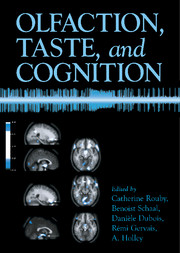Book contents
- Frontmatter
- Contents
- Contributors
- Preface
- Acknowledgments
- A Tribute to Edmond Roudnitska
- OLFACTION, TASTE, AND COGNITION
- Section 1 A Specific Type of Cognition
- Section 2 Knowledge and Languages
- Section 3 Emotion
- Section 4 Memory
- Section 5 Neural Bases
- 18 Odor Coding at the Periphery of the Olfactory System
- 19 Human Brain Activity during the First Second after Odor Presentation
- 20 Processing of Olfactory Affective Information: Contribution of Functional Imaging Studies
- 21 Experience-induced Changes Reveal Functional Dissociation within Olfactory Pathways
- 22 Increased Taste Sensitivity by Familiarization to Novel Stimuli: Psychophysics, fMRI, and Electrophysiological Techniques Suggest Modulations at Peripheral and Central Levels
- 23 The Cortical Representation of Taste and Smell
- Section 6 Individual Variations
- Index
- References
18 - Odor Coding at the Periphery of the Olfactory System
Published online by Cambridge University Press: 21 September 2009
- Frontmatter
- Contents
- Contributors
- Preface
- Acknowledgments
- A Tribute to Edmond Roudnitska
- OLFACTION, TASTE, AND COGNITION
- Section 1 A Specific Type of Cognition
- Section 2 Knowledge and Languages
- Section 3 Emotion
- Section 4 Memory
- Section 5 Neural Bases
- 18 Odor Coding at the Periphery of the Olfactory System
- 19 Human Brain Activity during the First Second after Odor Presentation
- 20 Processing of Olfactory Affective Information: Contribution of Functional Imaging Studies
- 21 Experience-induced Changes Reveal Functional Dissociation within Olfactory Pathways
- 22 Increased Taste Sensitivity by Familiarization to Novel Stimuli: Psychophysics, fMRI, and Electrophysiological Techniques Suggest Modulations at Peripheral and Central Levels
- 23 The Cortical Representation of Taste and Smell
- Section 6 Individual Variations
- Index
- References
Summary
During the past decade, scientists have identified a large number of genes coding for olfactory receptor proteins in vertebrates, including humans, and in insects and nematodes (Buck and Axel, 1991; Selbie et al., 1992; Sengupta, Colbert, and Bargmann, 1994; Gao and Chess, 1999; Clyne et al., 1999). Much earlier, such entities had been hypothesized to exist, probably on the intuition that the nature of an odor was not “ethereal” but rather a material part of the odor source (Lucretius, De rerum natura, IV) and thus could interact directly with the detecting organism. During the twentieth century, that concept was commonly used by physiologists to discuss the coding of odors (Zwaardemaker, 1925; Guillot, 1948) and by pioneer chemists who postulated receptive sites for odor molecules (Amoore, 1967; Beets, 1982). Its recent implementation in identifying receptor proteins has emitted a “strong scent of success” (Lancet, 1991). However, when the data from molecular biology and the physiological properties of the olfactory system are compared, it becomes clear that the final word has not yet been spoken on olfactory coding.
When olfactory signals are detected and differentiated, they gain behavioral significance when recognized as representing particular odor sources. In terms of neurophysiology, such processes require highly organized neuronal circuitry, and an important finding in recent studies of receptor proteins is that the receptors themselves are involved in determining the neural space devoted to representation of the chemical environment.
- Type
- Chapter
- Information
- Olfaction, Taste, and Cognition , pp. 293 - 308Publisher: Cambridge University PressPrint publication year: 2002
References
- 4
- Cited by

